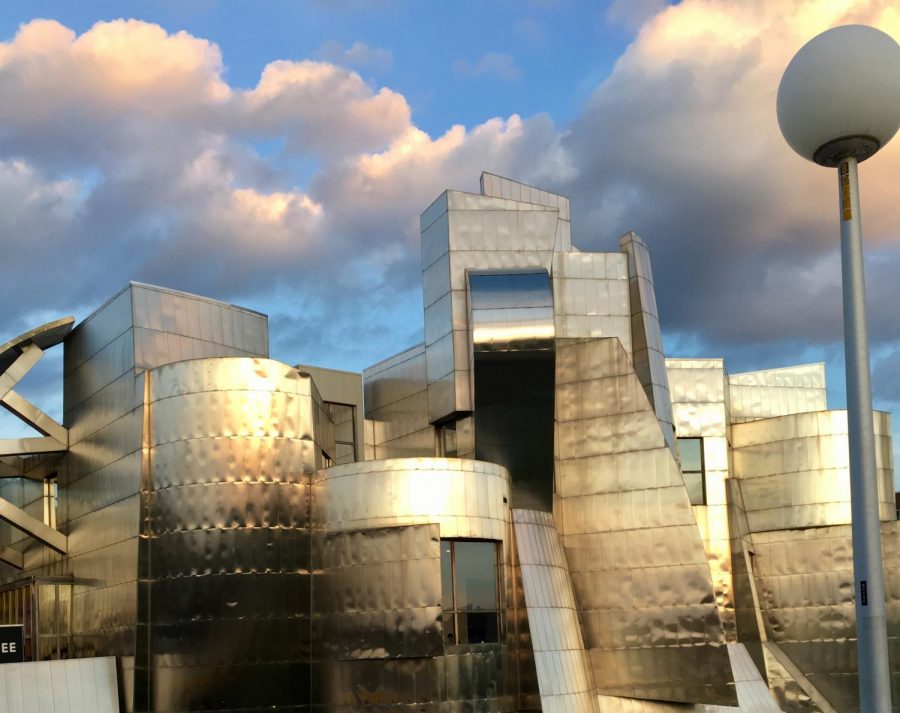Weisman Art Museum on the University of Minnesota Campus
Campus Contrived: The Weisman Fine art Museum
In Campus Contrived, the Minnesota Daily's newest series, writers uncover the stories backside underappreciated works of art and compages on the Twin Cities campus.

Emily Urfer
Weisman Art Museum on Friday, Sept. 6, 2019. The construction, completed in 1993, was designed past Frank Gehry.
Published Dec 1, 2021
The work of internationally renowned architect Frank Gehry never fit neatly into a box and defies the boundaries of labels. "My approach to architecture is dissimilar," Gehry one time said. "I desire to be open-ended. There are no rules, correct or wrong." The Weisman Art Museum (WAM), designed by Gehry, is a clear manifestation of this abstract and innovative take on architecture. The Academy of Minnesota campus gem hallmarks Gehry's infamous style with its fluid and innovative design, a step outside the box that's indicative of the University'southward values at large. Bearing the proper noun of philanthropist and fine art patron Frederick R. Weisman, the museum's construction was completed in 1993. But WAM'due south collection preceded the building it now calls home: it began equally the University Art Gallery, located in Coffman Memorial Spousal relationship. Diane Mullin, WAM's senior curator, is responsible for the museum's exhibitions and collections. Mullin explained that former WAM director Lyndel King played a large role in getting the gallery moved to its current location. "She felt that in that location should be a freestanding art museum for everybody on campus, not merely an fine art department," Mullin said. "She was the driving strength for that. She had a vision, and she said that we needed a edifice." Later on hearing most other works Gehry had done in Minnesota, like the Winton Invitee Business firm, Rex felt as though he should be deputed for the project. "She felt that he was a very important architect considering he used everyday things like stainless steel and concatenation link fences and took them out of context," Mullin said. This ingenuity is credible in all of Gehry's work, whether in terms of the materials he used or the abstract nature of his designs, and WAM is no exception. The museum'due south well-nigh defining characteristic is its glistening metal facades where its sharp, geometric edges work in tandem with fluid curvatures to create a cogitating buoy at the heart of campus. Tom Fisher is a professor of Architectural Theory and Urban Design at the University. Before he was a professor, Fisher worked as the editorial manager of Progressive Compages Mag and he spoke with Gehry for the publication multiple times. During their conversations, Fisher learned a lot about Gehry's artistic inspiration and the reason behind many of his design choices. "I was on the bridge looking at the edifice with him, and I asked what the inspiration was for that wrinkled metal facade, and he said 'look down.' If you look at the cliff face of the Mississippi right below the Weisman, the rock has the same kind of grey, fractured, angled advent," Fisher said. "He was making the argument that his building was contextual, because he was representing in metallic the same kind of forms that existed on the cliff confront correct below it." Fisher noted that this interaction spoke to Gehry's tendency to mimic natural forms in his work. "A lot of his buildings accept scale-similar metal cladding that look like the scales on a fish," he said. "I think he really likes the form of fish because it's a body that's evolved to move." Gehry'southward work began to utilise the appearance of motion more every bit technology evolved. Eric Amel, a Contemporary Compages History professor at the University, explained that the riverside metal facade was all hand-drawn. This side of the building uses descriptive geometry, which means that all of its forms can be developed into flat surfaces. The edifice's north-facing metal side, which looks towards Bruininks Hall and other campus buildings, was office of a 2011 expansion to the museum. Amel said that at this point, computer technology had evolved that immune Gehry to give the addition a more motion-similar appearance, made upwards of fluid metal ribbons and curves. The differences between these two sides of the building speak to the innovative nature of Gehry'southward work and how he's willing to adjust his manner with the changing technological landscape. "The side facing the river has a sure Gehry voice to information technology from the 1990s, and the side facing Bruininks is the side by side generation of Gehry," Amel said. "He's willing to combine both of those voices in the aforementioned edifice and be comfortable with it." Exterior of its reputation every bit an avante-garde fine art piece on campus, Mullin noted that the sense of innovation and creativity preserved inside the WAM edifice is an testament of the Academy's cadre values. "It'due south cutting edge, and the University is always cutting border, so I think it makes sense to invest in that kind of thinking," Mullin said. "Gehry questions traditions — he doesn't just uphold them. That's what a good University does."
Source: https://mndaily.com/270073/arts-entertainment/campus-contrived-the-weisman-art-museum/
0 Response to "Weisman Art Museum on the University of Minnesota Campus"
Post a Comment